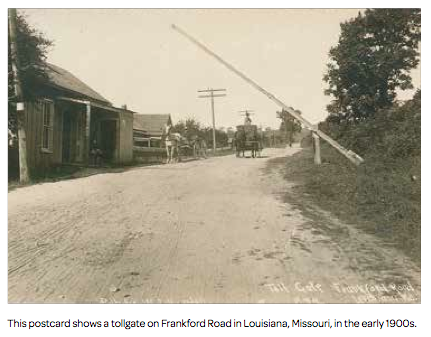Funding Missouri’s Highways
 Is it something in the water? Maybe it’s in the air we breathe. Perhaps it’s a mental defect, a misplaced gene or two. More than mere wisps of being contrarily stubborn, Missourians historically have refused to adequately fund their state’s basic transportation needs. How was it 60 years ago that our loathsome rival Kansas figured out a way to build a turnpike linking its three largest cities while this state struggled to four-lane a stretch of Highway 40 between the exurbs of St. Louis and High Hill? Maybe it goes back a few paces up the family tree to when an ancestor was gypped at the old tollbooth at Broadway and West Boulevard, irked at having to pay to use the muddy rutted old turnpike to Rocheport.
Is it something in the water? Maybe it’s in the air we breathe. Perhaps it’s a mental defect, a misplaced gene or two. More than mere wisps of being contrarily stubborn, Missourians historically have refused to adequately fund their state’s basic transportation needs. How was it 60 years ago that our loathsome rival Kansas figured out a way to build a turnpike linking its three largest cities while this state struggled to four-lane a stretch of Highway 40 between the exurbs of St. Louis and High Hill? Maybe it goes back a few paces up the family tree to when an ancestor was gypped at the old tollbooth at Broadway and West Boulevard, irked at having to pay to use the muddy rutted old turnpike to Rocheport.
Here we go again: Chapter CXVII in the extended play saga — devising an acceptable way to pay for the construction and maintenance of our sinewy network of roads and bridges. So the governor urgently telegraphs the Department of Transportation to produce a report by the end of the year about converting Interstate 70 into a toll road. And, please, hurry because we really do need to do something about the deteriorating condition of the state’s network of roads.
One cries for true leadership on this issue. Where is the modern-day equivalent to the late E. W. Stephens, the Columbia publisher who spearheaded the effort in 1920 to build a highway bridge across the Missouri River at Boonville? Seizing on the fact that the Army Corps of Engineers in 1890 had approved construction of a highway bridge across the river at a site identical to where the current bridge sits, Stephens and others canvassed the region, amassed a fund for construction, and the bridge was opened to traffic on July 4, 1924.
Stephens should be honored as one of Columbia’s true visionaries because the bridge cemented Columbia, Boonville and the shortest trans-state route westward to Kansas City against rival proposals through Fayette, Arrow Rock, Marshall and Glasgow and has played a significant role in the growth and development of Columbia. That’s nothing new here. The track of present-day Interstate 70 as a highway of significance was first outlined in 1938 and firmly cemented on maps of future divided highways released during World War II.
Missouri is hopelessly behind other states using motor fuel taxes to cover ongoing needs, and it would take a hike of 50 cents or more at the pump to make up our losses over time, so mark that one dead on arrival with voters. The electorate was just as hostile last August when a misguided proposal to add three-quarters of a penny to the general sales tax to fund transportation needs was on the ballot.
That leaves us with one other funding mechanism: tolls on the state’s high-volume interstate highways. First up is Interstate 70. People seem to complicate what could be done very easily. Create two wide spots on the road, and put up a row of booths that would include the EZ-Pass option. Choose two locations: proximate to State Route 13 on the west side of the state and west of Warrenton on the east side. Charge a dollar per vehicle; truckers, of course, should pay more.
It’s so simple and yet so complicated to ever think of getting done. We need to find a modern-day Donald M. Nelson (1888-1959; hometown: Hannibal, Missouri; B.S. in chemistry from MU, 1911), who went on to head the War Production Board (1942-1944) bogged down in the months after Pearl Harbor. Nelson’s efforts greatly helped us win the war. Somewhere there’s a clone of Nelson who’s ready to take up the cudgel and get Missouri moving a


